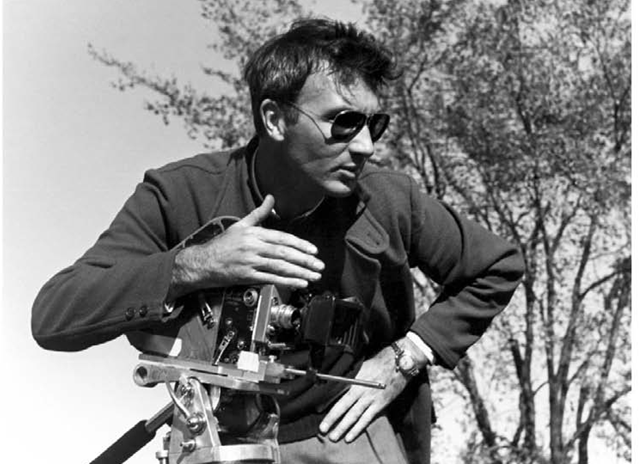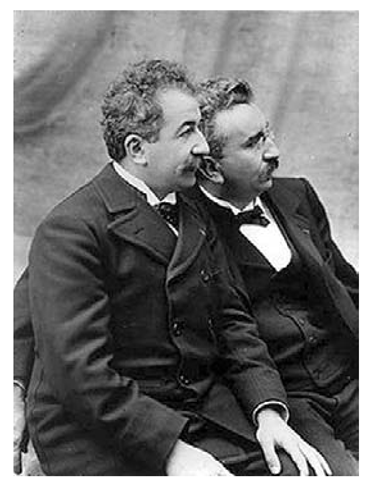Creating Magic
Humans are social creatures that have an innate need to share experiences and stories. Ever since humankind started communicating, stories, real and unreal, were shared around the communal circle. The tribe gathered together and a tale was told that revealed information, lessons, provocative thought, and emotional empathy. Often the more fantastic the story, the more entranced the audience became and the stronger the message. This might be the job of the shaman or chief, but soon everyone had stories and experiences to relate. Eventually stories became enhanced from the oral tradition through props and other means of visual storytelling. In just over the last hundred years, filmmaking became a powerful vehicle to relate stories and capture an audience’s imagination. Sight and sound are our most primal senses, and filmmaking taps into these receptors. Soon filmmaking started to expand its repertoire, and the "fantastic" became a possibility in storytelling.
Single-frame filmmaking has been around as long as film itself. The idea of fooling or tricking the eye has always been fascinating to people, and the manipulation of live-action filming was the origin of this technique. Imagine the early days of filmmaking, when audiences were seeing projected images on a screen, images that appeared to be alive and real, for the first time. That was magic in itself. When filmmakers became a bit more sophisticated, stopping the camera in mid-shoot and removing an object from in front of the camera then continuing to film, the results were genuinely magic. As film started to mature, artists and practitioners began to see the endless possibilities that this new medium offered. This stopping the motion of filming and adjusting images, cameras, and events is the predecessor to special effects and animation.
We are talking about stop-motion photography, which has evolved into many variations. The most common form of stop motion recognized today is model or puppet stop motion. In this, figurative models are made and animated frame by frame to create a narrative or experimental approach. Examples of this form are seen in films and on television. Feature films like Jiri Trnka’s A Midsummer Night’s Dream, Nick Park and Peter Lord’s Chicken Run, and Coraline directed by Henry Selick all exemplify this popular approach to figurative puppet stop motion. Television has also laid claim to this form of animation with popular programs like Pingu, Gumby, and the Rankin Bass Christmas special, Rudolph the Red Nosed Reindeer. These, among other titles in this genre, are well loved and considered more in the realm of traditional stop-motion puppet animation.
The nontraditional or alternative use of stop motion utilizes people; objects; various materials like sand, clay, paper; and often a mixture of these and other elements as the objects to be animated. The most common of the nontraditional alternative stop-motion techniques is known as pixilation.
This term is attributed to the Canadian animator, Grant Munro, who worked at the National Film Board of Canada with Norman McLaren in the 1940s, 1950s, and 1960s. Both McLaren and Munro were major contributors to this art form. In pixilation, usually, a person is animated like a puppet or model. There is a limited amount of registration in this approach to stop motion, so the result is a rather kinetic, bewitched, fragmentary movement that appears pixilated or broken up. It has nothing to do with the modern day term related to low-resolution digital images. Time-lapse photography and down shooting (animation on a custom animation stand, also known as multiplane animation) are two other forms of nontraditional alternative stop-motion animation. We explore each of these approaches and more in the following topics.
Silent Films and Beyond
This interest in the manipulation of filming and single-frame adjustment started as soon as film arrived on the scene in the late nineteenth and early twentieth century. The Lumiere Brothers are considered the first to successfully shoot and project films for audiences.
FIG 1.1 Auguste and Louis Lumiere, circa 1895.
Their work was amazing to the French and, ultimately, international audiences of the late 1890s. Everyday scenes of that era were well recorded and documented the factories and streets of Lyon, France. Once audiences became accustom to the novelty of moving images, the experimentation began. Several artists took the filmmaking technique much farther than Auguste and Louis Lumiere, the most significant of which was Georges Melies.
FIG 1.2 Georges Melies circa 1890.
The Parisian-born Melies was often referred to as the Cinemagician. His work with film was influenced by his experience as a stage magician. Melies learned how to use multiple exposures, dissolves, time-lapse photography, editing techniques, and substitution photography, in which the camera is stopped and the subject changed, to create a magical effect. These silent films created in the late nineteenth and early twentieth centuries were like magic shows that featured special effects. This kind of filmmaking was the precursor to several different branches in the tree of stop motion, including modern day special effects, puppet or model stop motion, and pixilation and its various forms. Melies’s The Conjuror, filmed in 1899, is a clear example of the relationship that he made between magic and his filmmaking.
Fig 1.3 The Conjuror, 1899.
He covers a woman with a cloth and pulls it off revealing that the woman has disappeared and reappeared on an adjacent table. He then, through what appears to be magic, continuously switches positions between him and the woman, using smoke and confetti to enhance the effect.
This is most likely attained through editing the film and re-enacting the action with different elements. The continuous movement of the actors helps create a smooth transition from one person or object to the next.
The editing process was the first technique used in the manipulation of imagery, but before too long, frame-by-frame manipulations shot in the camera became the most effective way to have ultimate control on the film’s outcome.
Another French contributor to stop motion and pixilation was Emil Cohl.
His 1911 film Jobard ne peut pas voir les femmes travailler (Sucker Cannot See the Women Working) utilized real people and is one of the earliest pixilated films known. Unfortunately, many of Cohl’s films have been lost due to fire and neglect.
The Edison Company, founded by Thomas Edison, created some of the first motion pictures in the United States in his infamous "Black Maria" studio in West Orange, New Jersey, in 1893.
FIG 1.4 The "Black Maria" studio, circa 1893.
Similar to the Lumiere Brothers, Edison’s first films reflected everyday life and activities. Edison also attracted audiences and talent, like the first established American stop-motion animators, James Blackton and Willis O’Brien. Both artists favored model or puppet animation. O’Brien produced special effects films like the 1915 The Dinosaur and the Missing Link: A Prehistoric Tragedy and eventually the 1933 King Kong. Artists were moving away from the obvious tricks of dissolves, position replacements, and editing techniques to techniques that were the beginnings of special effects and model animation. Pixilation took a back seat. Even artists like Charley Bower favored models, as is illustrated in his 1930 It’s a Bird, where Bowers has a bird eating metal materials and a car appears to be destroyed frame by frame as the film is run in reverse. This gives the appearance of the car assembling itself totally unassisted.
It is worth noting the Russian-born Polish animator, Ladislas Starevich, in 1910, was creating documentary films for the Museum of Natural History in Kovno, Lithuania. The final film in a series focused on the fighting of two stag beetles. Since these beetles would become dormant when the movie lights were on, Starevich decided to use dead beetles and attach wire with sealing wax to their thorax in place of their legs. This innovative thinking started a whole new approach to stop motion, which ultimately led to much more developed model animation.
In 1929, Russian director Dziga Vertov created a silent documentary film called Man with a Movie Camera. In this film, Vertov documents the lives of urban citizens in Odessa. The film, which was edited by his wife and partner, Elizaveta Svilova, features many of the techniques that we will discover in the following topics. Not only does Vertov use freeze frames, double exposures, reverse playback, fast and slow motion, dynamic camera angles, and editing techniques but also stop-motion approaches to reveal a rather frenetic and modern existence. It is worth viewing this wonderful documentary film for its historical and aesthetic approach.





